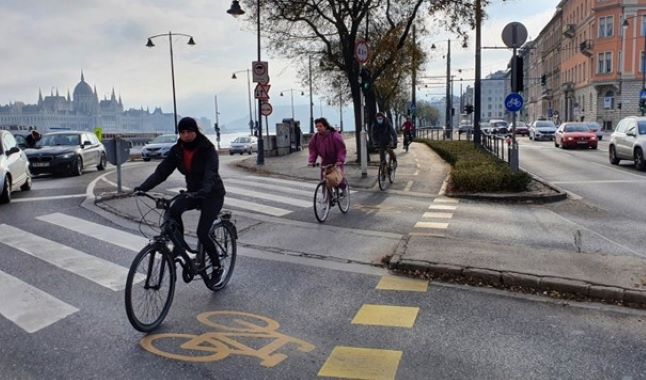
Budapest’s Year of the Bicycle: City Reports Record Increase in Cycling for 2020
Cycling confirmed as favoured transport alternative in the Hungarian capital as more citizens recognise the benefits of the bicycle. Record breaking stats show impressive progress in increasing cycling modal share, with a reported 15% growth in cycle traffic during 2020.
Like many other cities around Europe, the Hungarian capital experienced a cycling boom in 2020, with the Budapest centre for transport, Budapesti Közlekedési Központ (BKK) announcing a substantial increase in the number of cyclists on the city’s roads last year. According to BKK’s five publicly available electronic bicycle counters, 2,771,710 cycle trips were recorded, the highest figure ever reported since their synchronisation in 2017. Not even the cold winter months deterred bicycle users, as December’s figures reported an incredible 61% increase in trips compared to the same month in 2019.
As explained by ECF member, Hungarian Cyclists’ Club (HCC), much of this increase can be accredited to the mitigating circumstances of the COVID-19 pandemic. Cycling has proven to be the safest and most efficient means of transport during the pandemic, as it adheres to social distancing standards, reduces air pollution and keeps people physically active. Cycling also provides a viable means for leisure and exercise activities during lockdown, as other amenities are forced to close. Evidence demonstrates that cycling increased in both regards in Budapest, as bicycle traffic increased on both weekdays and public holidays in 2020, which is an outstanding result considering less people were commuting to work due to widespread teleworking protocols.
However, the pandemic is arguably only a catalyst for this change rather than the sole reason. Statistics show that Budapest’s growth in cycling did not only begin with the pandemic. As early as January 2020, BKK counters had measured 28% more cycle trips than a year before, indicating more and more people were already realising the benefits of cycling before lockdown measures were in place.
These statistics are a positive sign that Budapest is making significant progress in helping Hungary reach the cycling targets set out by the EU Cycle Strategy (EUCS). EUCS, a compilation of official recommendations co-authored by the European Cyclists’ Federation for delivering Green Growth through effective mobility, recommends that EU member states should aim to increase their cycling modal share by 50% by the year 2030.
Increased Investment Leads to Increased Cycling
Research undertaken by HCC suggests much of the increase in cycling in Budapest is due to the new bike lanes installed on several traffic arteries of the city. This research demonstrates that city residents are far more likely to cycle provided there are designated bicycle lanes and suitable roads available. As well as this, reconstruction on the city’s metro line M3 and Csepel HÉV suburban railway meant both transit options were closed during 2020, motivating an increase in bicycle traffic on the parallel routes of Museum Boulevard and Weiss Manfréd road. According to HCC, this increase in cycling as a popular transport alternative proves that it is worthwhile to continue developing bicycle lanes in the city, as they provide a cheap and convenient way to create both a viable transport alternative and a healthier environment.
 The best way to measure the effectiveness of improved cycling infrastructure is to record the resultant change in the number of cyclists. Besides representative surveys carried out by HCC, electric counters installed on bike lanes provided these important statistics for 2020. In Budapest, this data is publicly available from all of the 5 counters operated by BKK (Bem quay, Árpád bridge, Museum boulevard, Hungária boulevard, Weiss Manfréd road).
The best way to measure the effectiveness of improved cycling infrastructure is to record the resultant change in the number of cyclists. Besides representative surveys carried out by HCC, electric counters installed on bike lanes provided these important statistics for 2020. In Budapest, this data is publicly available from all of the 5 counters operated by BKK (Bem quay, Árpád bridge, Museum boulevard, Hungária boulevard, Weiss Manfréd road).
From April 2020, the bicycle counter data started to rise significantly compared to the year before. Except for October (the hot and sunny October of 2019 was surpassed only by the counter at Weiss Manfréd road), total bicycle traffic increased every month during 2020. The counters began to show significant increase during winter 2020 compared to the same period in 2019. The largest increase across all counters was measured in December, where between 29% and 95% of growth was measured across the 5 routes.

What to expect in 2021?
Restrictions due to the pandemic are set to remain in Hungary for the foreseeable future, at least until the majority of the population is vaccinated, but in order to make the city more liveable and sustainable, the growth of cycling must go beyond that. While 2020 showed incredible progress in achieving more cycling in Budapest and marked a significant change in collective behaviour and attitudes towards sustainable mobility, the return of car traffic and the lack of permanent commitment to cycling infrastructure may cause a drop in this favourable trend. To avoid this, substantial investments in safe and attractive infrastructure are needed. Together with its Hungarian member, HCC, ECF therefore calls upon the Hungarian government to make cycling investments an integral part of the National Recovery and Resilience Plan.
Cover photo: Cycling on the Bem quay in December 2020 by Áron Halász / Hungarian Cycling Club
Data and information for this article courtesy of Áron Halász / Hungarian Cycling Club
News category:
Contact the author
Recent news!
Upcoming events
Contact Us
Avenue des Arts, 7-8
Postal address: Rue de la Charité, 22
1210 Brussels, Belgium










